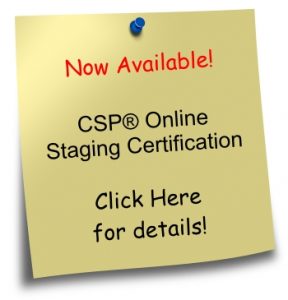Picture this: we’re sitting across from each other with our coffee, talking shop. I lean forward and ask you the question that’s been on my mind lately: “Is your phone ringing too much, or not at all?”
I’m seeing both extremes right now. One of our stagers just told me she staged 18 properties in three weeks and is completely booked for the month. Meanwhile, another stager says, “I’ve done everything right, and my phone isn’t ringing at all.” Same industry, same month, same town. Two totally different realities.
What’s the difference? It’s not luck or some secret formula. One person built her visibility, credibility, and connections before she desperately needed them. You know what they say about Rome.
We’re living in an instant-everything world, so when results don’t come immediately, we assume something’s broken. But real estate isn’t consistent, and staging follows the same unpredictable rhythm. If you’re in a slow period, this is actually your golden opportunity. If you’re swamped with work, now’s the time to think about long-term sustainability. A busy streak can evaporate overnight, and a quiet spell can suddenly explode into momentum, but only if you’re working the right plan.
These strategies come straight from what I teach in the CSP® program and through coaching. They’re designed to keep you top of mind, keep you booked, and build a rock-solid reputation without burning you out or forcing you to reinvent your entire business.
Ready to roll up your sleeves? Let’s dive in.
1. Show, Don’t Store: Give Your Portfolio Some Love
Be honest with me. How many staging jobs are sitting in your phone or buried in Dropbox, never making it to your portfolio?
Those hidden photos aren’t selling anything. Your portfolio is your handshake, your first impression, your silent salesperson working 24/7. If it’s outdated, cluttered, or missing your best work, it’s actually hurting you.
“But I haven’t had many paid jobs lately,” you might say. Let’s flip that thinking. Your portfolio isn’t just a highlight reel of sold homes. It’s a curated showcase of your skills and vision.
Here’s what you can do, even without recent client work:
- Dig up older projects that still represent your brand well
- Include those before-and-after shots from training or practice sessions at home
- Style and photograph vignettes in your own space that show off your strengths
- Organize everything into clear categories like “Condos,” “Bold Color Styling,” or “Occupied Homes”
- Build a mini-portfolio focused on a niche you want to grow, like short-term rentals or builder models
Here’s why this matters: Harvard Business Review found that 95% of buying decisions are emotional. Strong visuals create instant connection and build trust before you ever say a word.
Pro tip: Keep a simple spreadsheet with links to your photo albums by category. When an agent asks, “Do you have examples of condos?” you can respond in minutes, not days.
2. Rethink Your Consultation Process
When you walk into a property for a seller consultation, do you have a clear process, or are you winging it?
Too many talented stagers have amazing visual skills but cobbled-together consultation processes based on memory, guesswork, or whatever feels right in the moment. That approach won’t cut it anymore.
Your consultation shouldn’t be a casual walkthrough. It’s a professional service that deserves to be delivered like one. If we want respect for what we do as an industry, we need to step up our game. I genuinely believe the consultation is the foundation for getting a property sale-ready. A quick walk-through is an insult to clients whose equity is on the line.
A structured consultation makes you look polished, gives clients confidence, sets clear boundaries, and makes it easier to charge what you’re worth. More importantly, it positions you as a critical expert, not just a decorator with opinions.
Take a hard look at your current process:
- What do you send clients beforehand (welcome email, expectations, prep instructions)?
- Do you follow a repeatable workflow at each property?
- Are you giving homeowners something concrete they can reference later?
CSP® certified stagers use our standardized Room Ready™ Handbook, which walks them through a proven step-by-step process from arrival and initial dialogue through complete property review with detailed recommendations. It’s private, strategic, objective, and delivered professionally for a pre-paid fee.
If you’re still improvising or undercharging, it’s time to level up your process. This one change can completely transform how clients perceive your value and how confidently you present it.
The bottom line: When your consultation feels professional and organized, clients are much more likely to follow your recommendations and refer you to others.
3. Dip Your Toe Into Something New
Trends come and go, but solid strategy lasts forever. Adding a niche isn’t about chasing whatever’s hot right now. It’s about finding a market where your existing strengths solve real problems.
Diversification can be a lifeline. Additional services can stabilize your income during slow months and give you the freedom to say no to work that doesn’t excite you.
Is there a niche that’s been calling to you? Maybe short-term rentals, color consultations, decorating for everyday living, senior move management, residential transitions, or partnerships with builders and investors?
You don’t need to dive in headfirst. Start with one of these approaches:
- Take inventory of skills you already have that could serve that market
- Interview a colleague who’s successfully working in that space
- Invest in professional development training from a reputable source
Think of it as cross-training for your business. You’re building resilience and creating new income streams.
4. Build a Real Follow-Up System
If you’ve ever thought, “I should follow up with that agent…” and then didn’t, welcome to the club. Most stagers lose business not because clients said no, but because they never circled back.
We get busy, move on to the next thing, and assume they would have called if they were interested. Spoiler alert: they usually won’t, and it’s not because they don’t like you. People are busy. Following up isn’t pestering; it’s professional.
Here’s a reality check: Research shows 44% of salespeople (yes, that includes you) give up after just one follow-up attempt. Meanwhile, 80% of business connections require at least five follow-up touches to convert, with some needing as many as twenty.
What you can tackle this month:
- Set up a CRM or tracking system (even a basic spreadsheet works to start)
- Write 2-3 template follow-up emails you can customize (post-consultation, post-proposal, general check-in)
- Actually schedule follow-up reminders in your calendar, especially for past clients and agents
- Send casual messages like “Hope the listing went well, was just thinking of you!” to reopen conversations
Remember: You’re not just selling a service. You’re building relationships, and following up keeps those relationships alive.
If you’ve been meaning to build a CRM system but keep putting it off, we have a free resource that explains the power of having one and why it matters more than you think. You’ll find the link in our September newsletter, packed with insights on automation, contact strategy, and how to get started without tech overwhelm.
5. Prep Your Fall Marketing Now (Not When It’s Too Late)
Let me say this with love: September will be here before you know it, and if you wait until you’re in it, you’ll be scrambling.
Block off one afternoon this month and handle these basics:
- Create your September email, newsletter, or blog post (hint: this article could inspire it)
- Schedule two social media posts per week using a free tool like Buffer
You don’t need some complicated launch plan. You just need to be present and prepared. Consistency beats complexity every single time.
Bonus idea: Record a quick 2-minute video sharing one tip for sellers or agents. Save it. Post it in September. Done.
Marketing doesn’t have to be exhausting. It just has to exist. When people see you regularly, they remember you. When they remember you, they book you.
6. Ask for Referrals Smarter, Not Louder
Referrals aren’t lucky breaks. They’re planned outcomes.
Here’s something that might surprise you: 92% of people trust referrals from friends and family more than any advertisement (Nielsen study). If you’ve done great work, people actually want to refer you. They just need to be asked, and you need to make it easy and timely.
The best time to ask? Right after a successful job, when you get a glowing testimonial, or when a listing sells quickly.
Here’s how to build your referral system:
- Make a list of 5-10 past clients or agents you genuinely enjoyed working with
- Reach out with a warm check-in message (no hard sell)
- Simply ask, “If you know someone who could use staging help, would you mind passing my name along?”
- Make it effortless by creating a short, shareable email or PDF they can easily forward
Want to go one step further? Offer a simple referral thank-you gift. Even a $10 coffee card shows real appreciation.
Small Steps, Big Changes
If we were sitting together right now, I’d remind you of something important: Staging isn’t your business. It’s your product. Your business is visibility, trust, and systems that bring that product to the right people at the right time.
Whether you’re riding high or waiting for momentum to build, remember that this is exactly the time to do the work that creates stability. Building business momentum isn’t always about doing more. It’s about doing the right things consistently.
You don’t have to overhaul everything. Pick one or two items from this list and start there. Staying visible, staying valuable, and staying booked isn’t magic. It’s strategy, executed step by step.
And if you ever need fresh eyes on your situation or a plan to move forward faster, well, that’s exactly what coaching is for.
















 Subscribe Today!
Subscribe Today! 


